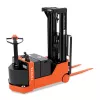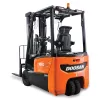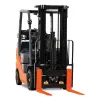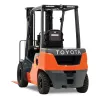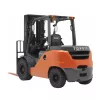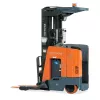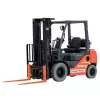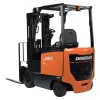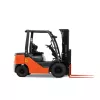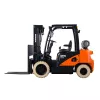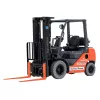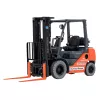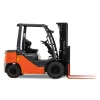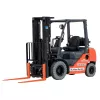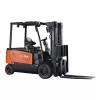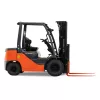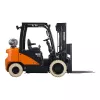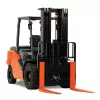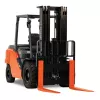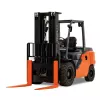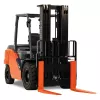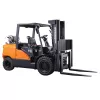En savoir plus sur les chariots élévateurs d’entrepôt
Choisissez parmi les locations de chariots élévateurs électriques, diesel ou à essence/propane avec des hauteurs de levage maximales allant jusqu’à 7 mètres et des capacités de charge maximales allant jusqu’à 22,7 tonnes. Ces modèles sont pourvus ou non de pneus renforcés pour conduire à l’intérieur ou de bandages pneumatiques, mieux adaptés aux surfaces extérieures lisses. Des modèles électriques plus petits à conducteur accompagnant sont également disponibles et peuvent soulever jusqu’à 2 tonnes. Notre stock comprend des chariots élévateurs à louer auprès de fabricants de confiance comme Toyota, Doosan, JCB et plus encore. Consultez notre article Project Uptime, 7 signaux manuels que tout opérateur de chariot élévateur doit connaître.
Pour plus d’informations sur nos chariots élévateurs d’entrepôt à louer, veuillez consulter notre section FAQ ci-dessous.
Les chariots élévateurs sont un équipement indispensable pour le travail en entrepôt; il en existe de nombreux types, en fonction de vos besoins spécifiques.
- Les chariots élévateurs d’entrepôt (également appelés chariots à mât rétractable ou chariots élévateurs) sont les plus reconnaissables avec leur carrosserie de la taille d’une voiturette de golf et leurs deux pinces de fourche qui dépassent à l’avant. Ces chariots élévateurs peuvent soulever entre 1,4 tonne et 22,7 tonnes.
- Les empileurs à conducteur accompagnant et chariots de magasinier sont tous d’excellentes options pour naviguer dans les allées étroites des entrepôts et permettent à l’opérateur de soulever et d’abaisser les palettes à diverses hauteurs. Ces chariots élévateurs peuvent soulever jusqu’à 2 tonnes.
En général, nos chariots élévateurs d’entrepôt à louer possèdent une hauteur maximale de la fourche comprise entre 3,4 et 4,6 mètres, tandis que les plus grands chariots élévateurs à mât quadruplex peuvent atteindre 6 mètres selon le modèle. Si vous recherchez une portée maximale dans vos applications, les chariots élévateurs à portée variable peuvent atteindre des hauteurs encore plus importantes.
La capacité maximale du chariot élévateur dépend de l’application et de la taille de la charge. Chaque chariot élévateur comprend une plaque requise par l’Occupational Safety and Health Administration (OSHA) indiquant la capacité de charge maximale. Avant de prendre une décision, déterminez les dimensions et le poids de votre charge la plus lourde, la hauteur à laquelle vous devez soulever la charge, le nombre d’heures d’utilisation de l’appareil de levage et l’environnement d’utilisation. United Rentals propose des chariots élévateurs à louer dont la capacité de charge peut aller jusqu’à 22,7 tonnes. United Rentals propose des chariots élévateurs à louer dont la capacité de charge peut aller jusqu’à 22,7 tonnes.
Les chariots élévateurs d’intérieur sont équipés de pneus renforcés ou en polyuréthane pour faciliter les manœuvres sur les sols lisses des entrepôts. Les chariots élévateurs extérieurs utilisent des pneus à bandes de roulement profondes et plus de garde au sol pour les rendre plus faciles à manœuvrer sur les terrains accidentés. En général, les roues et le châssis du chariot élévateur sont conçus pour un type de pneu spécifique, alors vérifiez le manuel du chariot élévateur avant d’utiliser un type de pneu différent de ce qui est recommandé. Il est rare que le chariot élévateur ait la capacité de passer d’un pneu renforcé à un bandage pneumatique.
